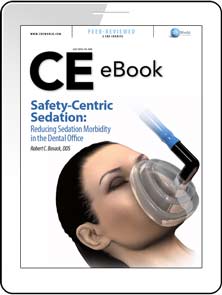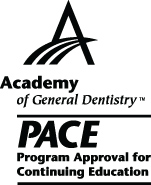CDEWorld > eBooks > Safety-Centric Sedation: Reducing Sedation Morbidity in the Dental Office


ADA CERP is a service of the American Dental Association to assist dental professionals in identifying quality providers of continuing dental education. ADA CERP does not approve or endorse individual courses or instructors, nor does it imply acceptance of credit house by boards of dentistry. Concerns or complaints about a CE provider may be directed to the provider or to ADA CERP at www.ada.org/cerp/

Approved PACE Program Provider. FAGD/MAGD credit. Approval does not imply acceptance by a state or provincial board of dentistry, or AGD endorsement. 1/1/2023 to 12/31/2028. ID # 209722.
eBook
Released: Monday, July 18, 2016
Expires: Tuesday, April 30, 2019
Safety-Centric Sedation: Reducing Sedation Morbidity in the Dental Office
By Robert C. Bosack, DDS
Commercial Supporter: Dentsply Sirona - Pharmaceuticals
Safety in any endeavor is a process that must be continually and relentlessly pursued. Risk can never be eliminated, but by engaging a culture of vigilance to expose and remediate the human and system weaknesses that contribute to adversity, it can be minimized. There is risk when dental patients are sedated in the office. This article outlines several avenues to manage this risk, which include but are not limited to improved and ongoing training of self and staff, strict patient screening, depth of anesthesia limit-setting, and vigilant patient monitoring. Establishment of a database of adverse events is recommended as a necessary part of a profession-wide culture of safety.
LEARNING OBJECTIVES:
-
Discuss techniques for the simulation of emergency scenarios that can occur during sedation of patients in the dental office
-
Distinguish potential alterations in airway patency, ventilatory, and cardiovascular function at various levels of sedation
-
Differentiate between patient resilience and reserve and how they influence patient selection for office-based sedation
About the Author
Dr. Bosack received his DDS from Loyola University School of Dentistry and completed a residency in oral and maxillofacial surgery at Cook County Hospital. He is active in private practice and also serves as a clinical assistant professor at the University of Illinois College of Dentistry. He is editor and author of Anesthesia Complications in the Dental Office (2015, Wiley Blackwell). He is the originator, developer, and executive director of Dental Anesthesia Online (www.daoce.org), an online continuing education resource in anesthesia. He currently serves on the Examination Committee for the American Board of Oral and Maxillofacial Surgery and has been named a content expert in anesthesia. He is a frequently invited speaker at state, regional, and national meetings. He has authored/coauthored numerous publications related to anesthesia.
Download FREE eBook now!

